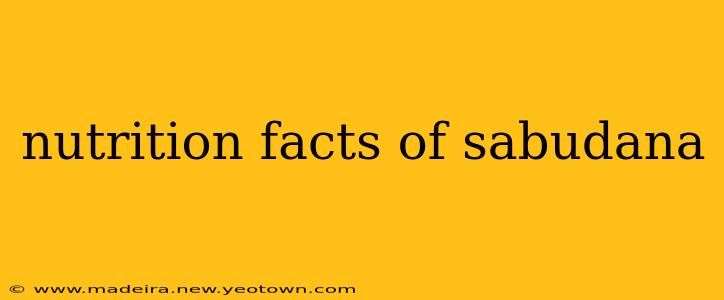Sabudana, also known as tapioca pearls or sago, holds a special place in many cuisines, particularly in India where it's a staple during fasting periods. But beyond its cultural significance lies a surprisingly rich nutritional profile. This isn't your average starch; let's delve into the fascinating world of sabudana nutrition and uncover its hidden benefits.
Imagine this: you're preparing a comforting bowl of sabudana khichdi, the aroma filling your kitchen. Little do you know, you're consuming a meal packed with essential nutrients that support your body's functions. Let's explore the detailed nutritional breakdown.
What are the nutritional benefits of sabudana?
Sabudana's nutritional value lies primarily in its carbohydrate content, offering a readily available source of energy. However, it also contains small amounts of vital minerals and vitamins, contributing to a balanced diet. While not a powerhouse of nutrients like some fruits and vegetables, it plays a specific role in a balanced diet, particularly for those seeking a gluten-free and easily digestible food source.
Is sabudana good for weight loss?
This is a question frequently asked. Sabudana is relatively low in fat and high in carbohydrates, offering a moderate source of energy. However, its calorie density is still relatively high compared to some other food groups. Therefore, while it won't directly contribute to weight loss on its own, moderation is key. Including sabudana as part of a balanced, calorie-controlled diet, alongside regular exercise, may support weight management goals. It’s not a magical weight-loss food, but it can be a part of a healthy eating plan.
What are the carbohydrates in sabudana?
Sabudana is primarily composed of carbohydrates, mainly in the form of starch. These carbohydrates provide the body with energy. The specific carbohydrate composition includes different types of starches that digest at varying speeds. This makes it important to consider portion sizes and how it fits within your overall diet.
What are the minerals and vitamins in sabudana?
While not exceptionally rich in vitamins and minerals, sabudana does offer small amounts of essential nutrients. These include:
- Potassium: Important for maintaining fluid balance and nerve function.
- Calcium: Crucial for strong bones and teeth.
- Iron: Essential for carrying oxygen throughout the body.
- Vitamin C (trace amounts): An antioxidant that supports the immune system. (Note: Vitamin C levels are generally low compared to other sources).
It's crucial to understand that these nutrients are present in relatively small quantities compared to other nutrient-dense foods. Therefore, relying solely on sabudana for micronutrients wouldn't be a good idea.
Is sabudana gluten-free?
Yes, sabudana is naturally gluten-free, making it a suitable option for individuals with celiac disease or gluten sensitivity. This makes it a valuable alternative starch source in many gluten-free diets.
What are the potential drawbacks of eating sabudana?
While generally safe for consumption, excessive consumption of sabudana can have certain drawbacks:
- High Glycemic Index: Sabudana has a relatively high glycemic index (GI), meaning it can cause a rapid spike in blood sugar levels. This is particularly important for individuals with diabetes who need to manage their blood sugar carefully. Portion control is essential.
- Limited Nutritional Profile: As mentioned before, sabudana isn't a complete source of nutrients. Relying heavily on it without other nutrient-rich foods can lead to nutritional deficiencies.
- Potential for Digestive Issues: Some individuals may experience digestive discomfort, such as bloating or gas, after consuming large quantities of sabudana.
Conclusion: Sabudana – A Balanced Approach
Sabudana, while not a miracle food, offers a valuable contribution to a balanced diet. Its easily digestible nature, gluten-free status, and moderate energy provision make it a suitable option for many. However, mindful consumption, portion control, and incorporation into a diverse diet are essential to reap its benefits and avoid potential downsides. Remember, a varied diet rich in fruits, vegetables, and other whole grains is always the best approach to overall health and wellbeing.

